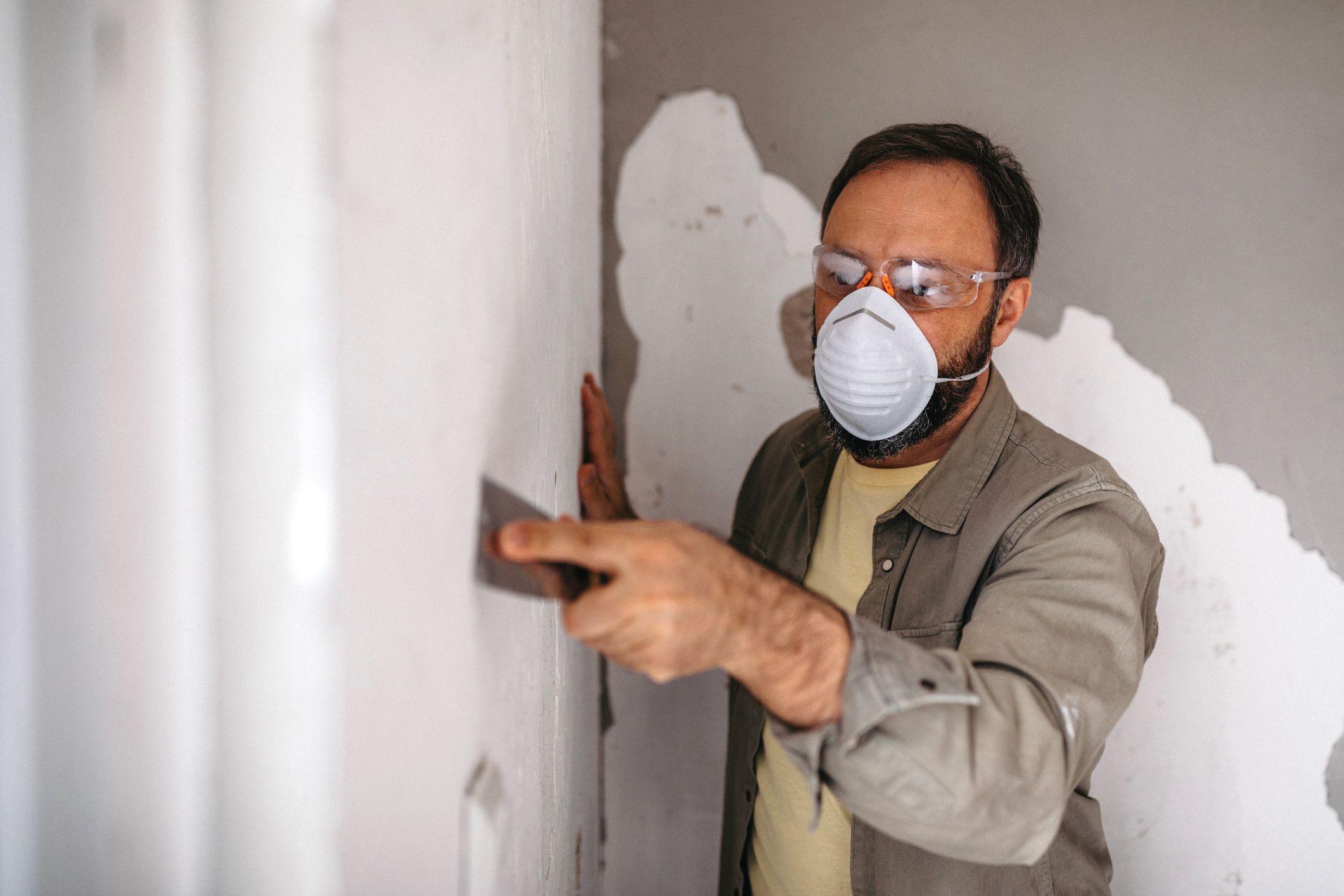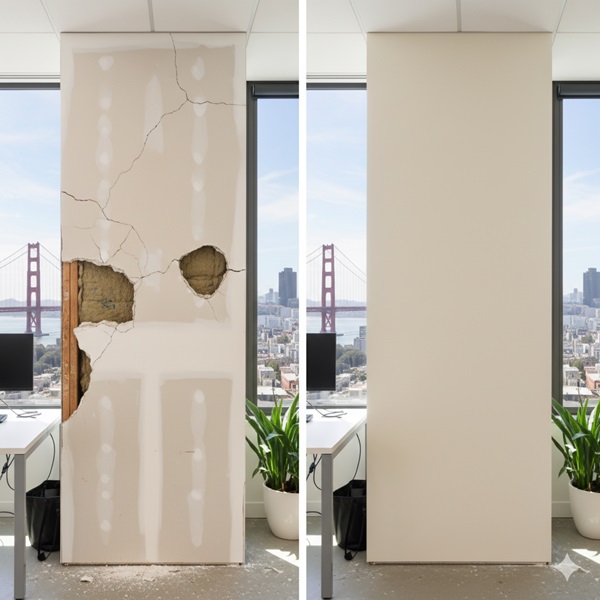Discover the Ideal Practices for Effective Drywall Repair and Setup
The art of drywall repair and setup calls for a mix of skill and precision. Understanding the essential tools is essential for achieving a smooth coating. Recognizing the step-by-step procedure can make a considerable difference in the last outcome. Appropriate strategies for taping and mudding are also critical. What remains is the understanding of upkeep that assures durability. These elements together create a refined outcome worth checking out better.

Vital Devices for Drywall Repair and Setup
When taking on drywall fixing and installation, having the right tools can significantly enhance the performance and quality of the work. An utility blade is necessary for reducing drywall sheets exactly, while a drywall saw can assist in making more complex cuts. Taping knives, readily available in different dimensions, are vital for applying joint substance efficiently and uniformly. A drywall sander, preferably with a dirt collection feature, helps accomplish a refined coating, decreasing the requirement for comprehensive cleaning.
In addition, a determining tape guarantees precise dimensions, and a degree ensures that installations are straight and plumb. Security gear, consisting of dirt masks and safety glasses, should not be forgotten to shield against debris and dust. A stud finder help in finding framing members, assuring safe and secure installation. By gearing up oneself with these essential tools, the repair work and setup procedure becomes much more convenient and leads to a professional-quality result.

Step-by-Step Overview to Patching Holes
Patching holes in drywall calls for a methodical technique to assure a seamless repair. The location around the opening need to be cleaned and any kind of loose debris removed. For little holes, a putty knife can be used to use a lightweight spackle, pressing it right into the hole and smoothing the surface. After it dries, fining sand is necessary to develop a flat coating. For bigger openings, a patch of drywall may be required. This involves cutting an item of drywall slightly bigger than the hole, protecting it to the wall surface with screws, and making use of joint compound to cover the seams. When the compound dries, it ought to be sanded smooth. Lastly, priming the patched area before paint will assure an even surface. Following these steps will result in a professional-looking repair service that blends seamlessly with the bordering wall.
Strategies for Seamless Drywall Setup
Accomplishing seamless drywall installation demands careful preparation and execution. First, it is vital to gauge and reduce drywall sheets properly to lessen voids. Making use of an energy blade, installers need to score the board prior to snapping it along the cut line, making certain clean sides. Correctly lining up the sheets is important; beginning from the top and working down assists keep harmony.
Securing drywall to the studs needs consistent spacing, usually every 16 inches, using screws instead of nails for better hold. This strategy reduces the risk of stands out over time. In addition, staggering the joints in between sheets improves structural honesty and reduces the presence of joints.
Lastly, utilizing the right thickness of drywall for particular areas-- such as moisture-resistant key ins shower rooms-- more adds to a remarkable surface. Complying with these strategies will result in a professional-looking and smooth setup, establishing the stage for the subsequent ending up processes.
Finishing Touches: Insulation and Mudding
Ending up touches, such as mudding and taping, play a necessary duty in attaining a polished drywall surface. Taping entails using a thin strip of drywall tape over the joints and joints, ensuring a seamless appearance. This procedure aids avoid cracks and produces a solid bond in between drywall sheets. It is vital to select the right kind of tape, with paper and fiberglass harmonize being the most common alternatives.
Mudding, or applying joint compound, complies with taping. This compound fills out spaces and ravel the surface for an uniform finish. It is normally used in several layers, with each coat requiring to dry before fining sand. Appropriate strategy involves feathering the sides to blend the substance right into the bordering drywall, reducing visibility.
When completed appropriately, mudding and taping improve both the visual and architectural integrity of the drywall installation, resulting in a professional-quality finish.
Tips for Keeping Your Drywall After Setup

In addition, preserving a regular interior humidity level can stop bending or mold and mildew development. Making use of a dehumidifier in moist locations, like cellars, is a good idea. It's likewise valuable to occasionally repaint locations that show wear, as this shields the underlying product. When moving furnishings or setting up components, care must be worked out to stay clear of damaging the drywall. By complying with these maintenance ideas, house owners can prolong the life of their drywall, safeguarding it remains an eye-catching function of their insides.
Often Asked Questions
What Safety And Security Gear Is Essential for Drywall Repair Service and Installment?
For drywall fixing and installation, crucial security equipment consists of security goggles to protect eyes, dirt masks to stop inhalation of bits, handwear covers for hand security, and knee pads for comfort during extended kneeling. drywall contractor.
How Do I Establish the Drywall Thickness Needed for My Job?
To establish the drywall density needed for a project, one should think about the wall surface's structural needs, neighborhood building ordinance, and the meant use the space, generally choosing 1/2-inch or 5/8-inch drywall.
Can I Fix Drywall Without Removing Furnishings From the Area?
Yes, drywall can be fixed without removing furniture from the area. Mindful planning and protective procedures can decrease mess, permitting efficient repairs while maintaining surrounding things safe from dust and damage throughout the process.
What Sorts of Drywall Are Best for Different Settings?
Moisture-resistant drywall is suitable for restrooms and cooking areas, while soundproof drywall suits shared wall surfaces in apartment or condos. Fire-rated drywall is best for garages, and conventional drywall works well as a whole living locations, ensuring sturdiness and viability for various atmospheres.
The length of time Does It Consider Drywall Mud to Dry Entirely?
Drywall mud usually takes 24 to 48 hours to completely dry totally, depending on elements like moisture and temperature (drywall contractors). Thicker applications might require longer drying out times, while thinner layers can dry quicker. Proper air flow aids drying out
The art of drywall repair and installation requires a mix of ability and precision. When embarking on drywall repair service and setup, having the right devices can considerably enhance the efficiency and high quality of the work. An energy blade is vital for cutting drywall sheets exactly, while a drywall saw can assist in making much more complex cuts. Attaining smooth drywall installation demands cautious preparation and implementation. Moisture-resistant drywall is perfect for kitchen areas and restrooms, while soundproof drywall matches shared wall surfaces in houses.